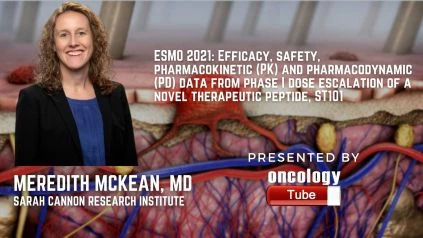Meredith McKean, MD, Associate Director, Melanoma and Skin Cancer Research Program at Sarah Cannon Research Institute speaks about ESMO 2021 Abstract – 525P – Efficacy, safety, pharmacokinetic (PK) and pharmacodynamic (PD) data from phase I dose escalation of a novel therapeutic peptide, ST101, targeting the oncogenic transcription factor C/EBPβ, in patients (pts) with advanced and metastatic solid tumors.
525P Abstract:
History:
CCAAT/enhancer-binding protein (C/EBP), an oncogenic transcription factor, promotes tumor survival and proliferation while blocking differentiation. ST101 is a C/EBP peptide antagonist having anti-tumor action in glioblastoma (GBM), breast cancer (BC), prostate cancer (PC), melanoma, and other cancer models.
Methodologies:
In patients with resistant solid tumors, we conducted the phase 1 section of phase 1-2 research. The primary goal was to assess ST101
‘s safety and tolerability. PK, preliminary efficacy and PD from repeated biopsies were secondary and exploratory objectives. ST101 IV doses of 0.5, 1, 2, 4, and 6 mg/kg were given weekly in a 3+3 design (QW). Phase 2 will involve four groups of patients with different cancers: breast, melanoma, GBM, and castrate-resistant prostate cancer.
Outcomes:
As of May 2021, 15 points had been enrolled, with the last cohort now in progress. The participants were treated for a median of 6 weeks (range 2–39). ST101 did not cause any DLTs, dosage changes, or SAEs. The only serious adverse events (AEs) were G1-2 histaminergic infusion-related responses (IRRs), primarily pruritis and urticaria, which were treated with antihistamines and infusion interruption/slowing. On the first dose of 4mg/kg, IRRs impacted 100% of the patients. With repeated treatment, the intensity and frequency of IRRs decreased. Other adverse effects were not regularly recorded. With prolonged exposure pre-dose QW, no signs of buildup, and no anti-drug antibodies, the PK was dose-proportionate. Tumor immunohistochemistry revealed dose-proportionate staining for ST101 and an inverse relationship with Ki67, implying that increasing dose reduces tumor proliferation. One patient with multi-metastatic cutaneous melanoma refractory to all standard therapy exhibited a partial response (confirmation pending), and three patients with various histologies had stable disease for 18-39 weeks (1 ongoing).
Findings:
ST101 was shown to be safe at all dosages tested, with evidence of efficacy at all dose levels, especially at larger doses. By September 2021, PK and PD support a dosage relationship for efficacy and the selection of a QW dose to begin phase 2 expansion cohorts.

